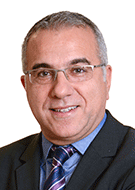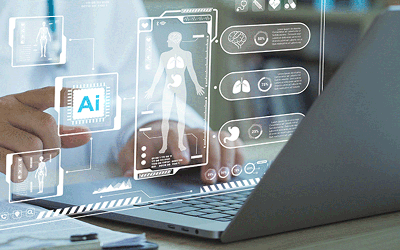How AI Is Reshaping Musculoskeletal Imaging
The promise and limitations of AI for MSK interpretation




This is the second article in a series focusing on advances in MSK imaging. Read the first story.
AI research and applications are expanding exponentially, offering opportunities to enhance each step of the musculoskeletal (MSK) imaging workflow, from pre-imaging tasks to image acquisition and analysis.
“With increasing clinical workloads, probably the greatest impact of AI is for minimizing the time spent by radiologists on routine, less complex functions of MSK imaging,” said Laura M. Fayad, MD, chief of musculoskeletal imaging and professor of radiology and radiological sciences at The Johns Hopkins School of Medicine in Baltimore.
Faster Images and More Detail
In terms of image acquisition, one of the biggest AI advances in MSK imaging is the reduction in MR acquisition time.
“Deep learning image reconstruction has already made a major impact on our daily clinical practice, facilitating substantially faster MRI acquisition of joints and the spine with higher spatial resolution and detail than conventional image reconstruction,” said Ali Guermazi, MD, PhD, MSc, professor of radiology and medicine at Boston University School of Medicine.
With the help of accelerated MR, the time to acquire a standard MRI of the knee has been reduced from 11 minutes to just over five.
“All of the major vendors have algorithms deployed on their hardware for MR acceleration,” said Akshay Chaudhari, PhD, assistant professor of radiology and associate director of the Stanford Center for Artificial Intelligence in Medicine and Imaging, in Stanford, CA. “Although there’s still research being done to try to understand the limits of acceleration.”
Images taken with the five-minute protocol are interchangeable with the ones taken with the conventional imaging protocol, according to Florian Knoll, PhD, professor in the Department of Artificial Intelligence in Biomedical Engineering at FAU Erlangen-Nürnberg in Bavaria, Germany. The accelerated examinations can be scheduled in 15-minute slots, similar to X-ray exams.
Pairing AI computational methods with lower field-strength MRI could also eliminate metal distortions and improve image quality for patients with metal implants by improving the signal-to-noise ratio.
"MRI is largely a first-world technology," said Dr. Knoll, also adjunct assistant professor at NYU Langone Health. "Lower-cost, low-strength systems could also be deployed in lower-resource countries, making MR more accessible around the world."

Support of Image Analysis and Triage
Dr. Chaudhari noted that there is a mismatch between the amount of AI research on image analysis—including automatic disease classification and image segmentation—and clinical adoption rates. Of the AI algorithms cleared by the FDA, only a handful have been successfully integrated into MSK clinical practice, including tools to detect bone fractures and produce quantitative measurements for scoliosis and limb lengths.
For example, triaging patients with a suspected bone fracture with AI software can decongest the ED and accelerate patient care. The software immediately reviews imaging studies and puts suspected fractures at the top of the pile for radiologists to review.
Radiologists are hoping that new AI tools will continue to emerge to further assist in imaging analysis, predicting the progression of disease, and delivering more personalized care.
“Many radiology tasks involve repetitive measurements, such as segmentation and calculation of volumes,” Dr. Knoll said. “It would be great to have an AI assistant to help with these low-level tasks.”
Applicable across radiology subspecialties, all radiologists interviewed for this article commented on the benefits of AI for managing administrative tasks, such as scheduling, triaging, and automatic protocoling that may save staff time and maximize patient throughput. Some radiology practices are already using AI to help optimize scheduling by using algorithms to predict and send reminders to potential no-shows.“I prefer the phrase ‘augmented intelligence’ because AI is a tool that can help radiologists improve their performance.”
– ALI GUERMAZI, MD, PHD, MSC
Barriers to Implementation
Although an inherent strength of AI is its ability to work with large amounts of data, AI models trained on specific populations or imaging equipment may have difficulty generalizing to different demographics or imaging modalities.
“The challenge is not so much scientific as it is the availability of structured data that can be brought together in a format that AI can work with,” Dr. Knoll said.
Future research hopes to optimize the generalizability of AI training datasets.
Integration of AI tools with existing RIS and PACS can also be challenging due to interoperability issues, especially for MSK-related images.
Specifically, MSK imaging involves various modalities that generate different types of images and data formats. Ensuring that AI tools can seamlessly integrate with and interpret data from these diverse modalities requires standardization efforts. These efforts can be hampered by variations in data formats.
Also, many health care institutions still use legacy RIS and PACS systems that were not designed with AI integration in mind. Retrofitting these systems to accommodate AI tools can be complex and expensive, often requiring updates to both hardware and software. In addition, there are security and privacy concerns over ensuring that AI algorithms comply with regulations such as HIPAA.
Nonetheless, MSK radiologists are embracing AI tools as a means of optimizing patient care.
“I prefer the phrase ‘augmented intelligence’ because AI is a tool that can help radiologists improve their performance,” Dr. Guermazi concluded.
For More Information
Connect with Dr. Guermazi on X @ali_guermazi.
Connect with Dr. Chaudhari on X @Dr_ASChaudhari or via LinkedIn.
Connect with Dr. Knoll via LinkedIn or on Facebook.
Read prior RNSA News stories about MSK imaging: